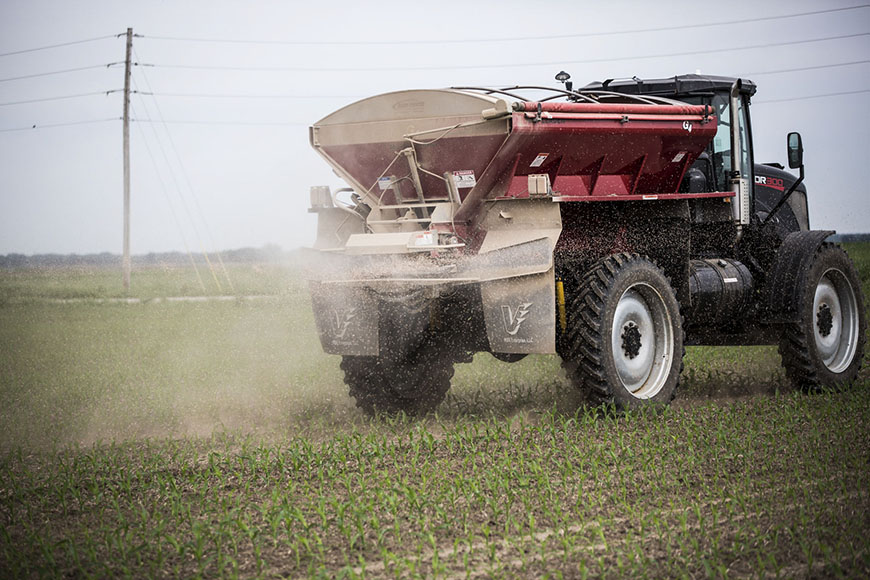Do Your Micronutrient Levels Measure Up?

By this time, most farmers have a good idea of how much nitrogen they plan to apply to their crops, but many haven’t given much thought to micronutrient fertilizers. The fact is, insufficient micronutrients can be just as detrimental to crop development as a macronutrient deficiency.
Know what plants need
By the time plants show symptoms of micronutrient deficiency, it’s often too late for corrective action. Having a pulse on the nutrient status of your crop throughout the season can allow for fertilization adjustments to mitigate deficiencies. Soil testing, done in conjunction with tissue testing, can provide a comprehensive set of data that can help you better understand nutrient availability and uptake to your crops.
The big three
You’d think that since micronutrients are only required in small amounts they’d rarely be limiting. The truth is, changes in field conditions and soil composition can impact micronutrient availability to plants. Zinc, boron and manganese are three common nutrients that farmers in the upper-Midwest may find deficient in their crops. Here are some things to keep in mind as you manage these micronutrients.
Unfortunately, there’s no one fertilizer recommendation that works for every situation. In order to evaluate your crop’s nutrient status, you’ll need to get in the field to soil and tissue sample.
Scout fields and continue to tissue-test throughout the season to understand and mitigate nutrient deficiencies.
We’re here to help you with your holistic plant nutrition plan. Next, we’ll explore how to mitigate in-season stress in corn and soybeans and how key micronutrients can help protect yield potential. We’ll continue to dig into all aspects of plant nutrition throughout the year right here on the Growing Knowledge blog, so be sure to check back for more plant health tips.
Know what plants need
By the time plants show symptoms of micronutrient deficiency, it’s often too late for corrective action. Having a pulse on the nutrient status of your crop throughout the season can allow for fertilization adjustments to mitigate deficiencies. Soil testing, done in conjunction with tissue testing, can provide a comprehensive set of data that can help you better understand nutrient availability and uptake to your crops.
The big three
You’d think that since micronutrients are only required in small amounts they’d rarely be limiting. The truth is, changes in field conditions and soil composition can impact micronutrient availability to plants. Zinc, boron and manganese are three common nutrients that farmers in the upper-Midwest may find deficient in their crops. Here are some things to keep in mind as you manage these micronutrients.
- Cool, wet springs lead to zinc deficiencies. Zinc assists with chlorophyll production in plants, so it’s an important nutrient for harnessing energy for grain production. Deficiencies are common in cold, wet soils and in soils with high pH, free calcium, and low organic matter. Supplemental zinc can be applied a number of ways, including as a seed treatment, included with starter fertilizer at planting or as a foliar application later in the season.
- Monitor boron levels in alfalfa crops. Alfalfa uses a lot of boron; therefore, it’s important to survey nutrient levels in an alfalfa crop. Like nitrogen, boron is mobile in soil and is prone to leaching, especially in sandy soils with low organic matter. Boron is important for proper nodule development and overall root growth in alfalfa.
- Herbicide applications can tie up manganese. Glyphosate can tie-up manganese in soybeans, making it unavailable to the plant. This is more common when crops are grown in organic soils with low pH that are deficient in manganese to begin with.
Unfortunately, there’s no one fertilizer recommendation that works for every situation. In order to evaluate your crop’s nutrient status, you’ll need to get in the field to soil and tissue sample.
Scout fields and continue to tissue-test throughout the season to understand and mitigate nutrient deficiencies.
We’re here to help you with your holistic plant nutrition plan. Next, we’ll explore how to mitigate in-season stress in corn and soybeans and how key micronutrients can help protect yield potential. We’ll continue to dig into all aspects of plant nutrition throughout the year right here on the Growing Knowledge blog, so be sure to check back for more plant health tips.

